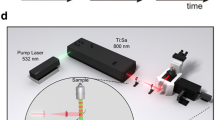Abstract
Caveolae are bulb-shaped invaginations of the plasma membrane that are enriched in specific lipids including cholesterol, phosphatidylserine and sphingolipids. Caveolae have many described cellular roles and functions, including endocytic transport, transcytosis, mechanosensing, and serving as a buffer against plasmalemmal stress. Caveola are formed through interactions between integral membrane proteins (Caveolin) and a cavin family of peripheral proteins (Cavins). Nearly half of the human proteome resides within or at the surface of membranes. Studying protein–protein interactions, especially of transmembrane domain containing proteins can be challenging. Fortunately, sophisticated biophysical methods allow for the monitoring of protein interactions in intact cells. Here, we describe the principles of Förster resonance energy transfer, fluorescence lifetime, and how their properties can be used to assess protein–protein interactions. Additionally, we discuss and demonstrate how fluorescence lifetime can be monitored microscopically thereby providing caveolin–cavin interaction data from living cells.
Access this chapter
Tax calculation will be finalised at checkout
Purchases are for personal use only
Similar content being viewed by others
References
Stokes GG (1852) On the change of refrangibility of light. Phil Trans R Soc (London) 142:463–562
O’Connor D (2012) Time-correlated single photon counting. Academic Press, New York
Berezin MY, Achilefu S (2010) Fluorescence lifetime measurements and biological imaging. Chem Rev 110:2641–2684
Ishikawa-Ankerhold HC, Ankerhold R, Drummen GPC (2012) Advanced fluorescence microscopy techniques--FRAP, FLIP, FLAP, FRET and FLIM. Molecules 17:4047–4132
Jablonski A (1933) Efficiency of anti-Stokes fluorescence in dyes. Nature 131:839–840
Sauer M, Hofkens J, Enderlein J (2010) Handbook of fluorescence spectroscopy and imaging: from ensemble to single molecules. Wiley, Hoboken, NJ
Förster T (1947) Fluoreszenzversuche an Farbstoffmischungen. Angew Chem A 59:181–187
Förster T (1948) Zwischenmolekulare Energiewanderung und Fluoreszenz. Ann Phys 437:55–75
Forster T (1946) Energiewanderung und Fluoreszenz. Naturwissenschaften 33:166–175
Forster T (1951) Fluoreszenz organischer Verbindungen. Vandenhoeck und Ruprecht, Göttingen
Clegg RM (2006) The history of Fret. In: Geddes CD, Lakowicz JR (eds) Reviews in fluorescence 2006. Springer US, Boston, MA, pp 1–45
Lakowicz JR (2006) Principles of fluorescence spectroscopy. Springer science & business media, New York, NY
Berney C, Danuser G (2003) FRET or no FRET: a quantitative comparison. Biophys J 84:3992–4010
dos Remedios CG, Moens PD (1995) Fluorescence resonance energy transfer spectroscopy is a reliable “ruler” for measuring structural changes in proteins. Dispelling the problem of the unknown orientation factor. J Struct Biol 115:175–185
Stryer L (1978) Fluorescence energy transfer as a spectroscopic ruler. Annu Rev Biochem 47:819–846
Lakowicz JR (2010) Frequency-domain lifetime measurements. In: Principles of fluorescence spectroscopy. Springer, Boston, MA, pp 157–204
Patterson GH, Piston DW, Barisas BG (2000) Förster distances between green fluorescent protein pairs. Anal Biochem 284:438–440
Wu P, Brand L (1994) Resonance energy transfer: methods and applications. Anal Biochem 218:1–13
Vogel SS, Thaler C, Koushik SV (2006) Fanciful FRET. Sci STKE 2006:re2
Hunt J, Keeble AH, Dale RE et al (2012) A fluorescent biosensor reveals conformational changes in human immunoglobulin E Fc: implications for mechanisms of receptor binding, inhibition, and allergen recognition. J Biol Chem 287:17459–17470
Harpur AG, Wouters FS, Bastiaens PI (2001) Imaging FRET between spectrally similar GFP molecules in single cells. Nat Biotechnol 19:167–169
Hötzer B, Ivanov R, Altmeier S et al (2011) Determination of copper(II) ion concentration by lifetime measurements of green fluorescent protein. J Fluoresc 21:2143–2153
Bastiaens PI, Squire A (1999) Fluorescence lifetime imaging microscopy: spatial resolution of biochemical processes in the cell. Trends Cell Biol 9:48–52
Chen Y, Mills JD, Periasamy A (2003) Protein localization in living cells and tissues using FRET and FLIM. Differentiation 71:528–541
Pietraszewska-Bogiel A, Gadella TWJ (2011) FRET microscopy: from principle to routine technology in cell biology. J Microsc 241:111–118
Auksorius E, Boruah BR, Dunsby C et al (2008) Stimulated emission depletion microscopy with a supercontinuum source and fluorescence lifetime imaging. Opt Lett 33:113–115
Borst JW, Visser AJ (2010) Fluorescence lifetime imaging microscopy in life sciences. Meas Sci Technol 21:102002
Day RN, Davidson MW (2012) Fluorescent proteins for FRET microscopy: monitoring protein interactions in living cells. BioEssays 34:341–350
Bajar BT, Wang ES, Zhang S et al (2016) A guide to fluorescent protein FRET pairs. Sensors (Basel) 16:1–24
Hill MM, Bastiani M, Luetterforst R et al (2008) PTRF-Cavin, a conserved cytoplasmic protein required for caveola formation and function. Cell 132:113–124
Tramier M, Zahid M, Mevel J-C et al (2006) Sensitivity of CFP/YFP and GFP/mCherry pairs to donor photobleaching on FRET determination by fluorescence lifetime imaging microscopy in living cells. Microsc Res Tech 69:933–939
Koushik SV, Chen H, Thaler C, Puhl HL, Vogel SS (2006) Cerulean, Venus, and VenusY67C FRET reference standards. Biophys J. 91(12):L99–L101
Acknowledgments
Original work in the laboratory of G.D.F. is supported by the Canadian Institutes of Health Research (Grants: PJT166010 and PJT165968) and the Natural Sciences and Engineering Research Council of Canada. Figures 1–3 were generated using BioRender.com.
Conflict of Interest: The authors declare that the research was conducted in the absence of any commercial or financial relationships that could be construed as a potential conflict of interest.
Author information
Authors and Affiliations
Corresponding author
Editor information
Editors and Affiliations
Rights and permissions
Copyright information
© 2022 The Author(s), under exclusive license to Springer Science+Business Media, LLC, part of Springer Nature
About this protocol
Cite this protocol
Nagwekar, J., Di Ciano-Oliveira, C., Fairn, G.D. (2022). Monitoring Transmembrane and Peripheral Membrane Protein Interactions by Förster Resonance Energy Transfer Using Fluorescence Lifetime Imaging Microscopy. In: Heit, B. (eds) Fluorescent Microscopy. Methods in Molecular Biology, vol 2440. Humana, New York, NY. https://doi.org/10.1007/978-1-0716-2051-9_4
Download citation
DOI: https://doi.org/10.1007/978-1-0716-2051-9_4
Published:
Publisher Name: Humana, New York, NY
Print ISBN: 978-1-0716-2050-2
Online ISBN: 978-1-0716-2051-9
eBook Packages: Springer Protocols




